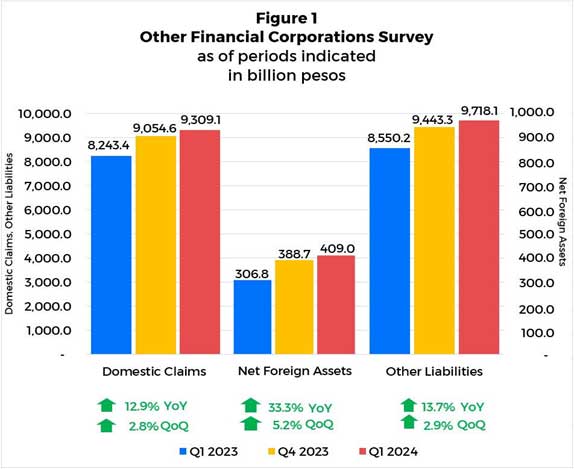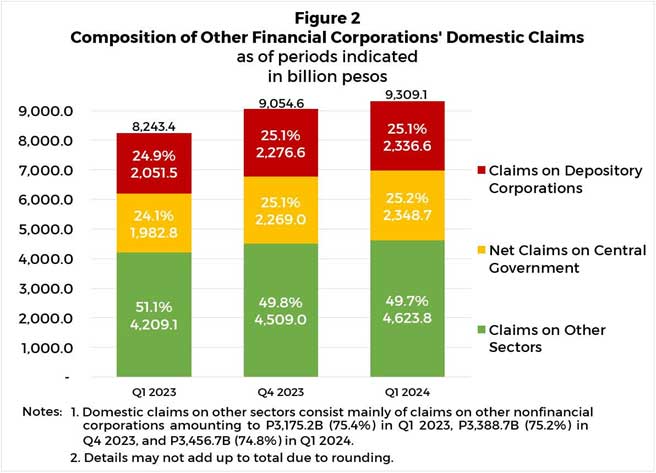Domestic claims of other financial corporations increased by 2.8 percent quarter-on-quarter (QoQ) in Q1 2024, according to preliminary results from the Other Financial Corporations Survey. [1]
The sector’s domestic claims totaled ₱9,309.1 billion, up from ₱9,054.6 billion in Q4 2023 and ₱8,243.4 billion in Q1 2023.

This growth was driven by increased claims on other sectors, the central government, and depository corporations. [2]
Investments in equity shares issued by nonfinancial corporations and loans to households bolstered these claims.
Claims on the central government rose due to higher holdings of government-issued debt securities, while deposits with banks and bank-issued equity shares pushed up claims on depository corporations.
The sector’s net foreign assets grew by 5.2 percent QoQ to ₱409.0 billion, fueled by investments in nonresident-issued equity shares. Meanwhile, other liabilities increased due to a rise in equity issuances and insurance technical reserves. [3]
On a year-on-year (YoY) basis, domestic claims expanded by 12.9 percent, a deceleration from the 15.0 percent growth in Q4 2023. The increase was mainly due to claims on the private sector, central government, and depository corporations. [4]
The net foreign assets saw a YoY growth of 33.3 percent, down from 48.0 percent in the previous quarter.

By component, claims on the other sectors, specifically the other nonfinancial corporations, comprised the bulk of the other financial corporations’ domestic claims in Q1 2024 (Figure 2). This is followed by claims on the central government and the depository corporations.
[1] The Other Financial Corporations Survey is a comprehensive measure of the claims and liabilities of the other financial corporations. Other financial corporations refer to institutional units providing financial services other than banks, non-banks with quasi-banking functions, non-stock savings and loan associations, and the central bank. These institutional units are comprised of non-money market funds of trust institutions, trust corporations, and investment companies, private and public insurance corporations, holding companies, government-owned or -controlled corporations engaged in financial intermediation, and other financial intermediaries and auxiliaries.
[2] The other sectors are comprised of (a) state and local government, (b) public nonfinancial corporations, and (c) private sector. The private sector is composed of other nonfinancial corporations and other resident sectors. The other nonfinancial corporations refer to private corporations and quasi-corporations whose principal activity is the production of market goods or nonfinancial services. Meanwhile, other resident sectors comprise the households and non-profit institutions serving households. Moreover, the depository corporations are composed of (a) the central bank, and (b) other depository corporations (i.e., deposit-taking corporations, except the central bank).
[3] The insurance technical reserves are amounts set aside by insurance companies to meet future insurance liabilities, such as but not limited to unearned premiums, outstanding claims, expected losses, bonuses and rebates (for life insurance).
[4] The other financial corporations’ claims on the private sector grew as its investments in equity shares issued by other nonfinancial corporations and loans extended to the household sector increased.





















